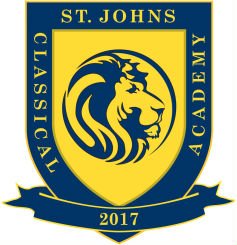Grammar School
Curriculum Maps
The foundation for St. Johns Classical Academy’s curriculum is the Core Knowledge Sequence. The Core Knowledge Sequence is based upon E.D. Hirsch’s idea of cultural literacy, which makes it the ideal basis for a Classical Liberal Arts school. The Core Knowledge Sequence provides a grade-by-grade sequence of specific topics to be taught in grades K-8. Topics taught include history, geography, literature, visual arts, music, language arts, science and math. The content of the topics is based upon basic principles that are lasting and solid; for example, important events of world history, essential elements of math, and essential elements of written expression.
As learning becomes more meaningful if knowledge is built on prior knowledge, the Core Knowledge Sequence provides a specific outline of the skills and content to be learned grade by grade. Thus, all children are exposed to knowledge needed to be included in a shared literate culture. Teachers and parents are all on the same page, and the chance of repetition and/or gaps as children move from grade to grade are eliminated. The curriculum constitutes approximately 50% of what is taught so teachers have the freedom to develop their own knowledge goals as well.
The Sequence provides content and skill guidelines for all core content areas, recommending coherent, cumulative, and content-specific topics to be taught at each grade level, from kindergarten through eighth grade. It addresses skills-based topics in language arts (decoding, handwriting, spelling, and written composition), geography (spatial sense), history and science. The Sequence is designed so that, whenever possible, related topics in literature, history, science, music, and art are covered together, so that students can create connections and see the rich and varied perspectives provided by each discipline. We have taken great care in selecting specific instructional materials and curriculum resources that are aligned with the content and structure of the Core Knowledge Sequence and that adhere to the framework of a classical educational model.
For specific curriculum mapping and subjects, please visit http://www.coreknowledge.org/.
To provide a foundation in numeric literacy, St. Johns Classical Academy has adopted Singapore Math. Singapore Math is a program that presents mathematical skill building and problem solving from a conceptual viewpoint. It saves instructional time by focusing on mastery of essential math skills, not on re-teaching skills that should have been mastered in prior grades. The program’s detailed instruction, questions, problem solving, and visual and hands-on aids ensure that students master the material. Ideally, students do not move on until they have thoroughly learned a topic.
Singapore textbooks are designed to build a deeper understanding of mathematical concepts as opposed to just memorizing algorithms and formulas. The focus on number sense, geometry, spatial relationships and measurement in the early grades make it a perfect match for the new Florida State Standards. Additionally, the coherence of the strategies used build from one idea to the next and is carried throughout all grade levels, giving students the tools needed for confidence in mathematical concepts.
Singapore Math’s placement tests facilitate ability grouping for optimal student success. A daily math block will be scheduled for the purpose of ability-grouping students in K-8th grades, allowing for the needs of both mathematically- competent students as well as struggling learners to be met. Indeed, the country of Singapore embraced a common core standard for mathematics years before the United States proposed such action. In Singapore Math, each element of the system — the framework, a common set of national standards, texts, tests, and teacher preparation programs — is carefully aligned to clear and common goals. Each semester-level Singapore Math textbook builds upon preceding levels, and assumes that what was taught need not be taught again. Consequently, it is necessary to assign Singapore Math students to a textbook that matches what they are ready to learn next. By contrast, the typical US classroom offers the same grade-level math instruction to all students, reviews previously taught math skills before teaching new skills, and gives more emphasis to topics that don’t build on previously taught math skills (bar graphs, geometric shapes, measurement units).
A great deal of instructional time is saved by focusing on essential math skills, and by not re-teaching what has been taught before. In fact, some teachers report that Singapore Math feels slower paced than what they’re used to.
However, the result is that students master essential math skills at a more rapid pace. By the end of sixth grade, Singapore Math students have mastered multiplication and division of fractions, and they are comfortable doing difficult multi-step word problems. With that foundation, they are well prepared to complete Algebra 1 in middle school.
The hallmark of the curriculum is the careful guidance of students, done in a child-friendly pictorial language, not only to technical mastery, but to complete understanding of all the “whys”. This differs from typical U.S. curricula, which either aim for dogmatic memorization of “rules,” or expect students to reconstruct mathematical ideas from hands-on activities without much guidance.


